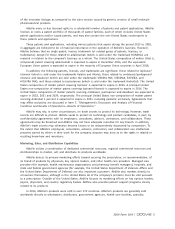AbbVie 2014 Annual Report Download - page 21
Download and view the complete annual report
Please find page 21 of the 2014 AbbVie annual report below. You can navigate through the pages in the report by either clicking on the pages listed below, or by using the keyword search tool below to find specific information within the annual report.
13NOV201221352027
Roche Holding AG to discover, develop, and commercialize a next-generation Bcl-2 inhibitor, ABT-199, for
patients with relapsed/refractory chronic lymphocytic leukemia.
Failures by these parties to meet their contractual, regulatory, or other obligations to AbbVie, or any
disruption in the relationships between AbbVie and these third parties, could have an adverse effect on
AbbVie’s pharmaceutical pipeline and business. In addition, AbbVie’s collaborative relationships for research
and development extend for many years and may give rise to disputes regarding the relative rights,
obligations and revenues of AbbVie and its collaboration partners, including the ownership of intellectual
property and associated rights and obligations. This could result in the loss of intellectual property rights or
protection, delay the development and sale of potential pharmaceutical products, and lead to lengthy and
expensive litigation or arbitration.
Biologics carry unique risks and uncertainties, which could have a negative impact on future results
of operations.
The successful discovery, development, manufacturing and sale of biologics is a long, expensive and
uncertain process. There are unique risks and uncertainties with biologics. For example, access to and
supply of necessary biological materials, such as cell lines, may be limited, and governmental regulations
restrict access to and regulate the transport and use of such materials. In addition, the development,
manufacturing, and sale of biologics is subject to regulations that are often more complex and extensive
than the regulations applicable to other pharmaceutical products. Manufacturing biologics, especially in
large quantities, is often complex and may require the use of innovative technologies. Such manufacturing
also requires facilities specifically designed and validated for this purpose and sophisticated quality
assurance and quality control procedures. Biologics are also frequently costly to manufacture because
production inputs are derived from living animal or plant material, and some biologics cannot be made
synthetically. Failure to successfully discover, develop, manufacture and sell biologics—including HUMIRA—
could adversely impact AbbVie’s business and results of operations.
AbbVie’s biologic products may become subject to competition from biosimilars.
The Biologics Price Competition and Innovation Act was passed on March 23, 2010 as Title VII to the
Patient Protection and Affordable Care Act. The law created a framework for the approval of biosimilars in
the United States and could allow competitors to reference data from biologic products already approved.
In Europe, the European Commission has granted marketing authorizations for several biosimilars pursuant
to a set of general and product class-specific guidelines for biosimilar approvals issued over the past few
years. In addition, companies are developing biosimilars in other countries that could compete with
AbbVie’s biologic products. If competitors are able to obtain marketing approval for biosimilars referencing
AbbVie’s biologic products, AbbVie’s products may become subject to competition from such biosimilars,
with the attendant competitive pressure and consequences. Expiration or successful challenge of AbbVie’s
applicable patent rights could also trigger competition from other products, assuming any relevant
exclusivity period has expired. As a result, AbbVie could face more litigation with respect to the validity
and/or scope of patents relating to its biologic products.
New products and technological advances by AbbVie’s competitors may negatively affect AbbVie’s
results of operations.
AbbVie competes with other research-based pharmaceuticals and biotechnology companies that
discover, manufacture, market, and sell proprietary pharmaceutical products and biologics. For example,
HUMIRA competes with a number of anti-TNF products that are approved for a number of disease states
and AbbVie’s virology products compete with protease inhibitors and other anti-HIV treatments. These
competitors may introduce new products or develop technological advances that compete with AbbVie’s
products in therapeutic areas such as immunology, virology/liver disease, renal disease, dyslipidemia, and
neuroscience. AbbVie cannot predict with certainty the timing or impact of the introduction by competitors
2014 Form 10-K 15
























